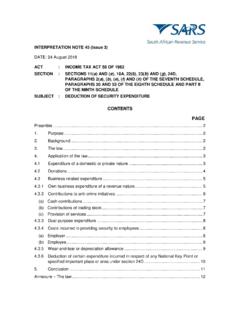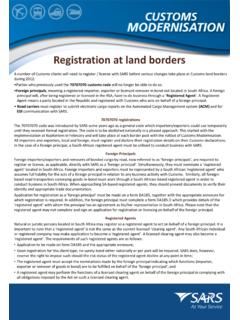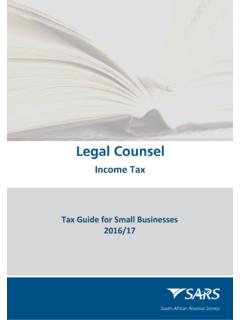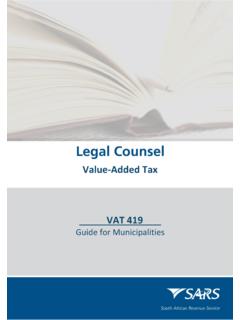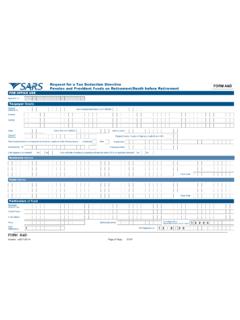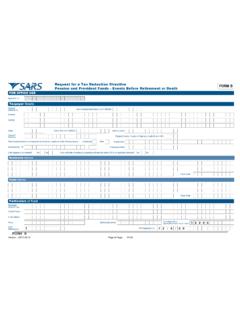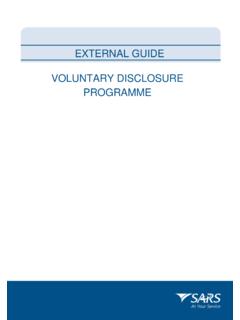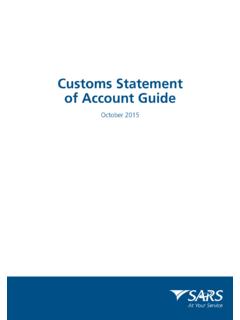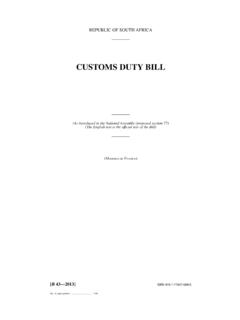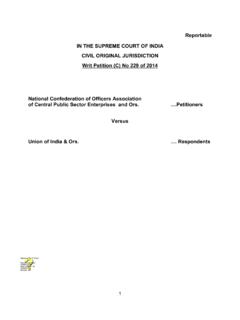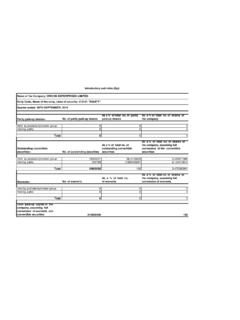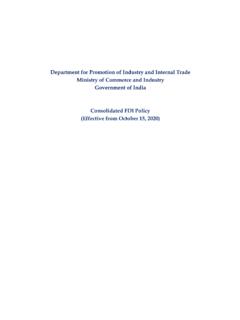Transcription of TAX GUIDE 2021 - South African Revenue Service
1 1 EnglishBUDGETTAX GUIDE20211 This SARS tax pocket GUIDE provides a synopsis of the most important tax, duty and levy related information for 2021/22. INCOME TAX: INDIVIDUALS AND TRUSTSTax rates from 1 March 2021 to 28 February 2022:Individuals and special trustsTaxable Income (R)Rate of Tax (R)1 216 20018% of taxable income216 201 337 80038 916 + 26% of taxable income above 216 200337 801 467 50070 532 + 31% of taxable income above 337 800467 501 613 600110 739 + 36% of taxable income above 467 500613 601 782 200163 335 + 39% of taxable income above 613 600782 201 1 656 600229 089 + 41% of taxable income above 782 2001 656 601 and above587 593 + 45% of taxable income above 1 656 600 Trusts other than special trusts: rate of tax 45%Rebates Primary R15 714 Secondary (Persons 65 and older) R8 613 Tertiary (Persons 75 and older) R2 871 Age Tax Threshold Below age 65 R87 300 Age 65 to below 75 R135 150 Age 75 and over R151 1002 Provisional TaxA provisional taxpayer is any person who earns income by way of remuneration from an unregistered employer, or income that is not remuneration, or an allowance or advance payable by the person s principal.
2 An individual is not required to pay provisional tax if he or she does not carry on any business, and the individual's taxable income: Will not exceed the tax threshold for the tax year; or From interest, dividends, foreign dividends, rental from the letting of fixed property, and remuneration from an unregistered employer will be R30 000 or less for the tax tax returns showing an estimation of total taxable income for the year of assessment are required from provisional estates are not provisional fund lump sum withdrawal benefitsTaxable income (R)Rate of tax (R)1 25 0000% of taxable income25 001 - 660 00018% of taxable income above 25 000660 001 - 990 000114 300 + 27% of taxable income above 660 000990 001 and above203 400 + 36% of taxable income above 990 000 Retirement fund lump sum withdrawal benefits consist of lump sums from a pension, pension preservation, provident, provident preservation or retirement annuity fund on withdrawal (including assignment in terms of a divorce order).
3 3 Tax on a specific retirement fund lump sum withdrawal benefit (lump sum X) is equal to: The tax determined by the application of the tax table to the aggregate of lump sum X, plus all other retirement fund lump sum withdrawal benefits accruing from March 2009, all retirement fund lump sum benefits accruing from October 2007, and all severance benefits accruing from March 2011; less the tax determined by the application of the tax table to the aggregate of all retirement fund lump sum withdrawal benefits accruing before lump sum X from March 2009, all retirement fund lump sum benefits accruing from October 2007, and all severance benefits accruing from March fund lump sum benefits or severance benefitsTaxable income (R)Rate of tax (R)
4 1 500 0000% of taxable income500 001 - 700 00018% of taxable income above 500 000700 001 1 050 00036 000 + 27% of taxable income above 700 0001 050 001 and above130 500 + 36% of taxable income above 1 050 000 Retirement fund lump sum benefits consist of lump sums from a pension, pension preservation, provident, provident preservation or retirement annuity fund on death, retirement or termination of employment due attaining the age of 55 years, sickness, accident, injury, incapacity, redundancy or termination of the employer s trade. Severance benefits consist of lump sums from or by arrangement with an employer due to relinquishment, termination, loss, repudiation, cancellation or variation of a person s office or on a specific retirement fund lump sum benefit or a severance benefit (lump sum or severance benefit Y) is equal to: The tax determined by the application of the tax table to the aggregate of amount Y plus all other retirement fund lump sum benefits accruing from October 2007 and all retirement fund lump sum withdrawal benefits accruing from March 2009 and all other severance benefits accruing from March 2011.
5 Less the tax determined by the application of the tax table to the aggregate of all retirement fund lump sum benefits accruing before lump sum Y from October 2007 and all retirement fund lump sum withdrawal benefits accruing from March 2009 and all severance benefits accruing before severance benefit Y from March Dividends received by individuals from South African companies are generally exempt from income tax, but dividends tax, at a rate of 20%, is withheld by the entities paying the dividends to the individuals. Dividends received by South African resident individuals from REITs (listed and regulated property owning companies) are subject to income tax, and non-residents in receipt of those dividends are only subject to dividends Dividends Most foreign dividends received by individuals from foreign companies ( shareholding of less than 10% in the foreign company ) are taxable at a maximum effective rate of 20%.
6 No deductions are allowed for expenditure to produce foreign exemptions Interest from a South African source, earned by any natural person under 65 years of age, up to R23 800 per annum, and persons 65 and older, up to R34 500 per annum, is exempt from income tax. Interest earned by non-residents, who are physically absent from South Africa for at least 182 days during the 12 month period, before the interest accrues and the interest bearing debt is not effectively connected to a fixed place of business in South Africa, is exempt from income fund contributions Amounts contributed to pension, provident and retirement annuity funds during a year of assessment are deductible by members of those funds.
7 Amounts contributed by employers and taxed as fringe benefits are treated as contributions by the individual employees. The deduction is limited to of the greater of the amount of remuneration for PAYE purposes or taxable income (both excluding retirement fund lump sums and severance benefits). The deduction is further limited to the lower of R350 000 or of taxable income before the inclusion of a taxable capital gain. Any contributions exceeding the limitations are carried forward to the immediately following year of assessment and are deemed to be contributed in that following year. The amounts carried forward are reduced by contributions set off against retirement fund lump sums and retirement and disability expensesIn determining tax payable, individuals are allowed to deduct: Monthly contributions to medical schemes (a tax rebate referred to as a medical scheme fees tax credit) by the individual who paid the contributions up to R332 for each of the first two persons covered by those medical schemes, and R224 for each additional dependant.
8 And in the case of: An individual who is 65 years and older, or if an individual, his or her spouse, or his or her child is a person with a disability, of the sum of qualifying medical expenses paid and borne by the individual, and an amount by which medical scheme contributions paid by the individual exceed three times the medical scheme fees tax credits for the tax year; or any other individual, 25% of an amount equal to the sum of the qualifying medical expenses paid and borne by the individual, and an amount by which medical scheme contributions paid by the individual exceed four times the medical scheme fees tax credits for the tax year, limited to the amount which exceeds of taxable income (excluding retirement fund lump sums and severance benefits).
9 Donations Deductions in respect of donations to certain public benefit organisations are limited to 10% of taxable income (excluding retirement fund lump sums and severance benefits). The amount of donations exceeding 10% of the taxable income is treated as a donation to qualifying public benefit organisations in the following tax allowances and advancesWhere the recipient is obliged to spend at least one night away from his or her usual place of residence on business, and the accommodation to which that allowance or advance relates is in the Republic of South Africa, and the allowance or advance is granted to pay for meals and incidental costs or incidental costs only, an amount, published on the SARS website , under Legal Counsel / Secondary Legislation / Income Tax Notices / 2021.
10 Is deemed to have been expended per the accommodation to which that allowance or advance relates is outside the Republic of South Africa, a specific amount per country is deemed to have been expended. Details of these amounts are published on the SARS website , under Legal Counsel / Secondary Legislation / Income Tax Notices / 2019 Where the recipient is by reason of the duties of his or her office or employment obliged to spend a part of a day away from his or her usual place of work or employment, a reimbursement or advance for expenditure actually incurred by the recipient is exempt if the recipient is allowed by his or her principal to incur expenditure on meals and other incidental costs for that part of a day and the amount of the expenditure does not exceed an amount published on the SARS website.
